Mass Flow Monitoring by Distributed Fiber Optical Temperature Sensing
Abstract
:1. Introduction
2. Materials and Methods
2.1. Experimental Setup
2.2. Flow Control
2.3. Heating
2.4. Fiber Optical Temperature Sensing
2.5. Finite Element Analysis (FEA)
3. Experimental Results
3.1. Heat Diffusion: Zero Flow Experiment
3.2. Forced Heat Convection: Flow Experiment
3.3. Finite Element Analysis
3.4. Comparison Experiment and Simulation
3.5. Analysis of the Temperature Distribution
4. Discussion
5. Conclusions
Author Contributions
Funding
Acknowledgments
Conflicts of Interest
References
- Lee, B. Review of the present status of optical fiber sensors. Opt. Fiber Technol. 2003, 9, 57–79. [Google Scholar] [CrossRef]
- Bao, X.; Chen, L. Recent Progress in Distributed Fiber Optic Sensors. Sensors 2012, 12, 8601–8639. [Google Scholar] [CrossRef] [PubMed] [Green Version]
- Bruun, H.H. Hot-Wire Anemometry: Principles and Signal Analysis; Oxford University Press: Oxford, UK, 1995. [Google Scholar]
- Wylie, M.T.V.; Brown, A.W.; Colpitts, B.G. Distributed hot-wire anemometry based on Brillouin optical time-domain analysis. Opt. Express 2012, 20, 15669–15678. [Google Scholar] [CrossRef] [PubMed]
- Gerald, D.B.; Stephen, W.J.; Ralph, P.T. A Bragg grating based fiber optic reference beam laser Doppler anemometer. Meas. Sci. Technol. 2001, 12, 909. [Google Scholar]
- Chen, R.; Yan, A.; Wang, Q.; Chen, K.P. Fiber-optic flow sensors for high-temperature environment operation up to 800 °C. Opt. Lett. 2014, 39, 3966–3969. [Google Scholar] [CrossRef]
- Garcia-Ruiz, A.; Dominguez-Lopez, A.; Pastor-Graells, J.; Martins, H.F.; Martin-Lopez, S.; Gonzalez-Herraez, M. Long-range distributed optical fiber hot-wire anemometer based on chirped-pulse ΦOTDR. Opt. Express 2018, 26, 463–476. [Google Scholar] [CrossRef]
- Liu, G.; Sheng, Q.; Hou, W.; Han, M. Optical fiber vector flow sensor based on a silicon Fabry-Perot interferometer array. Opt. Lett. 2016, 41, 4629–4632. [Google Scholar] [CrossRef]
- Balakrishnan, V.; Phan, H.P.; Dinh, T.; Dao, D.V.; Nguyen, N.T. Thermal Flow Sensors for Harsh Environments. Sensors 2017, 17, 2061. [Google Scholar] [CrossRef]
- van Putten, A.F.P.; Middelhoek, S. Integrated silicon anemometer. Electron. Lett. 1974, 10, 425. [Google Scholar] [CrossRef]
- Nguyen, N.T. Micromachined flow sensors—A review. Flow Meas. Instrum. 1997, 8, 7–16. [Google Scholar] [CrossRef]
- Baltes, H.; Paul, O.; Brand, O. Micromachined thermally based CMOS microsensors. Proc. IEEE 1998, 86, 1660–1678. [Google Scholar] [CrossRef]
- Amira, Z.; Bouyahi, M.; Ezzedine, T. Measurement of Temperature through Raman Scattering. Procedia Comput. Sci. 2015, 73, 350–357. [Google Scholar] [CrossRef] [Green Version]
- Hwang, D.; Yoon, D.J.; Kwon, I.B.; Seo, D.C.; Chung, Y. Novel auto-correction method in a fiber-optic distributed-temperature sensor using reflected anti-Stokes Raman scattering. Opt. Express 2010, 18, 9747–9754. [Google Scholar] [CrossRef] [PubMed]
- Bolognini, G.; Hartog, A. Raman-based fibre sensors: Trends and applications. Opt. Fiber Technol. 2013, 19, 678–688. [Google Scholar] [CrossRef]
- Shiota, T.; Wada, F. Distributed temperature sensors for single-mode fibers. Int. Soc. Opt. Engineering 1991, 1586, 13–19. [Google Scholar] [CrossRef]
- Ukil, A.; Braendle, H.; Krippner, P. Distributed temperature sensing: Review of technology and applications. IEEE Sens. J. 2011, 12, 885–892. [Google Scholar] [CrossRef]
- Horiguchi, T.; Tateda, M. Optical-fiber-attenuation investigation using stimulated Brillouin scattering between a pulse and a continuous wave. Opt. Lett. 1989, 14, 408. [Google Scholar] [CrossRef]
- Kurashima, T.; Horiguchi, T.; Tateda, M. Distributed-temperature sensing using stimulated Brillouin scattering in optical silica fibers. Opt. Lett. 1990, 15, 1038. [Google Scholar] [CrossRef]
- Bao, X.; Dhliwayo, J.; Heron, N.; Webb, D.J.; Jackson, D.A. Experimental and theoretical studies on a distributed temperature sensor based on Brillouin scattering. J. Light. Technol. 1995, 13, 1340–1348. [Google Scholar] [CrossRef]
- Alekseev, A.E.; Vdovenko, V.S.; Gorshkov, B.G.; Potapov, V.T.; Simikin, D.E. A phase-sensitive optical time-domain reflectometer with dual-pulse phase modulated probe signal. Laser Phys. 2014, 24, 115106. [Google Scholar] [CrossRef]
- Kreger, S.T.; Gifford, D.K.; Froggatt, M.E.; Soller, B.J.; Wolfe, M.S. High Resolution Distributed Strain or Temperature Measurements in Single- and Multi-Mode Fiber Using Swept-Wavelength Interferometry. In Optical. Fiber Sensors; OSA: Washington, DC, USA, 2006; p. ThE42. [Google Scholar] [CrossRef]
- Zhang, L.; Wang, Z.; Li, J.; Zeng, J.; Li, Y.; Jia, X.; Rao, Y. Ultra-long dual-sideband BOTDA with balanced detection. Opt. Laser Technol. 2015, 68, 206–210. [Google Scholar] [CrossRef]
- Nikitin, S.P.; Kuzmenkov, A.I.; Gorbulenko, V.V.; Nanii, O.E.; Treshchikov, V.N. Distributed temperature sensor based on a phase-sensitive optical time-domain Rayleigh reflectometer. Laser Phys. 2018, 28, 085107. [Google Scholar] [CrossRef]
- Lu, X.; Soto, M.A.; Thévenaz, L. Novel technique for distributed fibre sensing based on coherent Rayleigh scattering measurements of birefringence. In Sixth European Workshop on Optical Fibre Sensors; Lewis, E., Ed.; SPIE: Bellingham, WA, USA, 2016; p. 991633. [Google Scholar] [CrossRef]
- Gifford, D.K.; Kreger, S.T.; Sang, A.K.; Froggatt, M.E.; Duncan, R.G.; Wolfe, M.S.; Soller, B.J. Swept-wavelength interferometric interrogation of fiber Rayleigh scatter for distributed sensing applications. In Optics East 2007; SPIE: Bellingham, WA, USA, 2007; Volume 6770, p. 67700. [Google Scholar] [CrossRef]
- White, F. Fluid Mechanics (Mcgraw-Hill Series in Mechanical Engineering), 7th ed.; Mcgraw-Hill Science/Engineering/Math: New York, NY, USA, 2010; p. 896. [Google Scholar]
- Toolbox, E. Thermal Conductivity of Common Materials and Gases. Available online: https://www.engineeringtoolbox.com/thermal-conductivity-d_429.htmL (accessed on 23 January 2019).
- Polyimide. Available online: http://www.mit.edu/~6.777/matprops/polyimide.htm (accessed on 23 January 2019).
- Blumm, J.; Lindemann, A. Characterization of the Thermophysical Properties of Molten Polymers and Liquids Using the Flash Technique. High Tem. High Press. 2002, 35, 627–632. [Google Scholar] [CrossRef]
- Goldstein, R.J. Fluid Mechanics Measurements, 2nd ed.; Taylor & Francis: Washington, DC, USA, 1996. [Google Scholar]

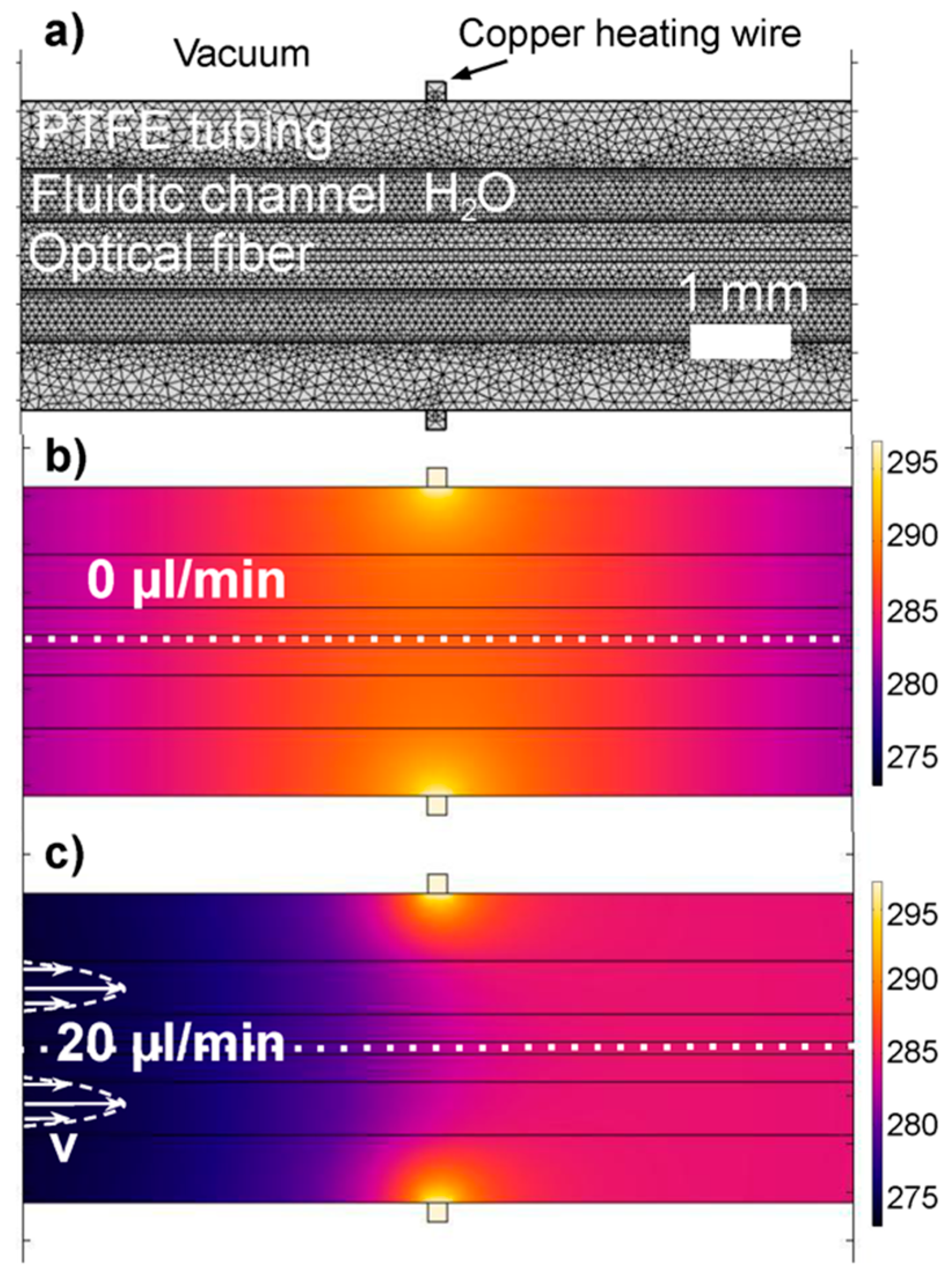

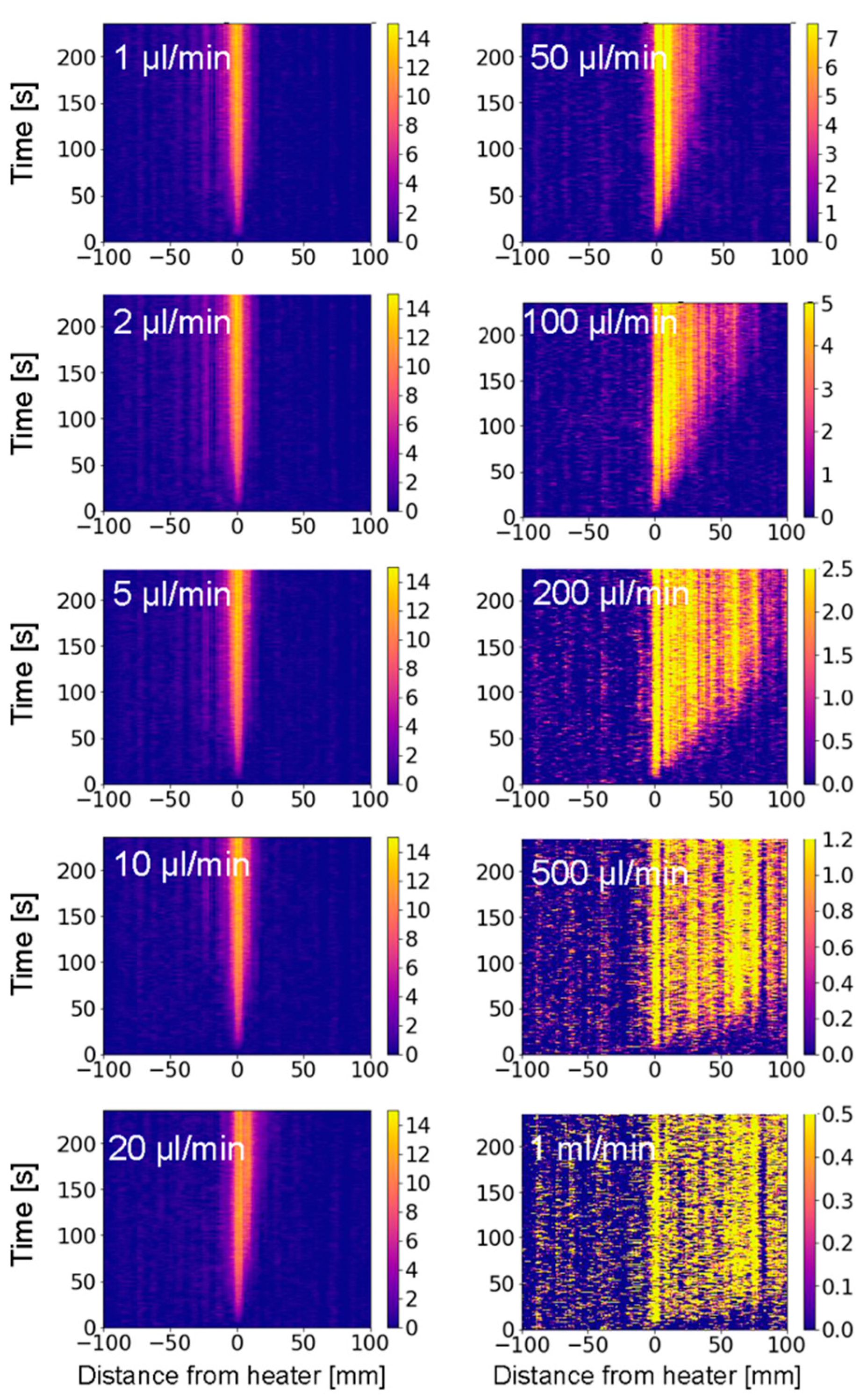
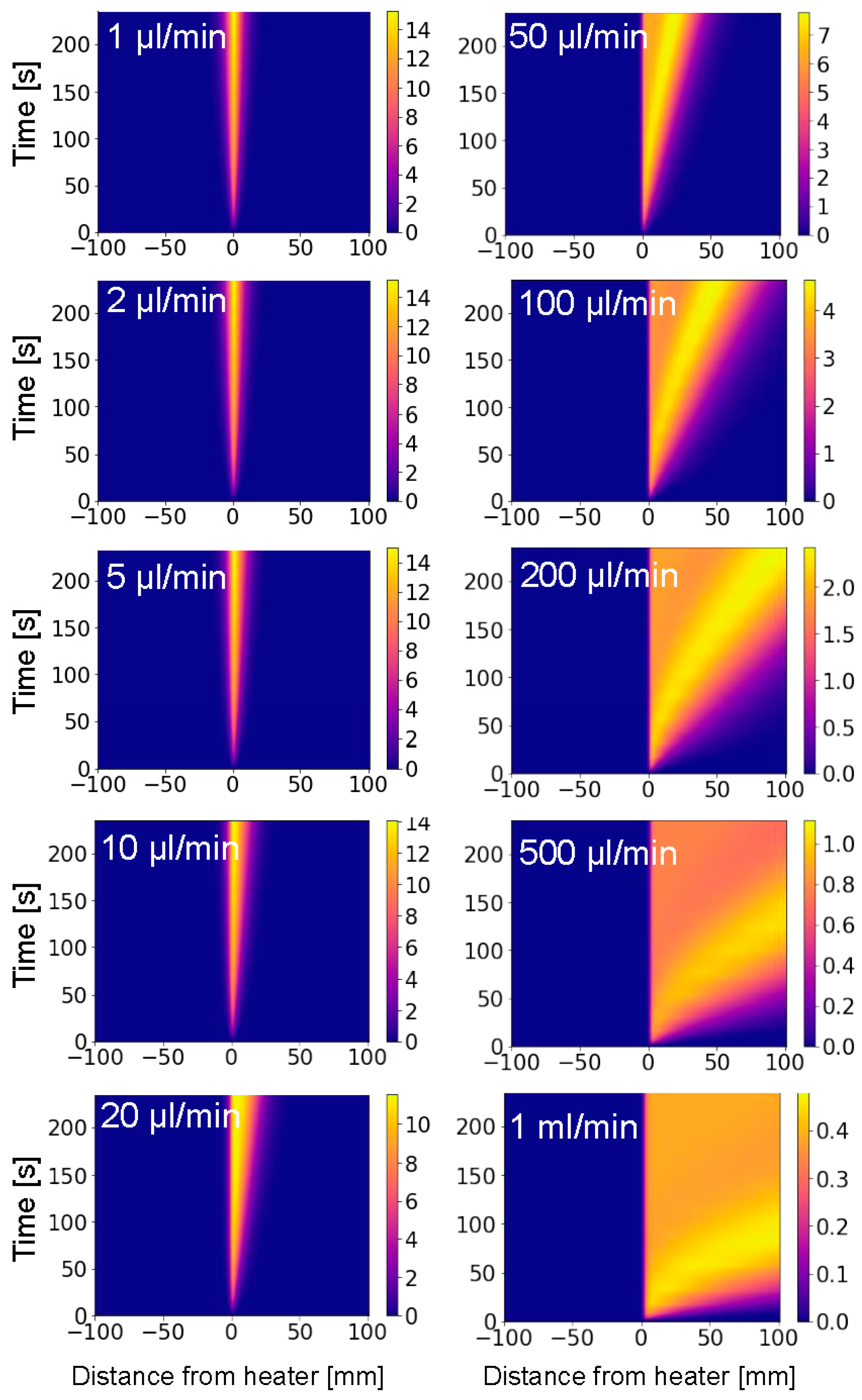
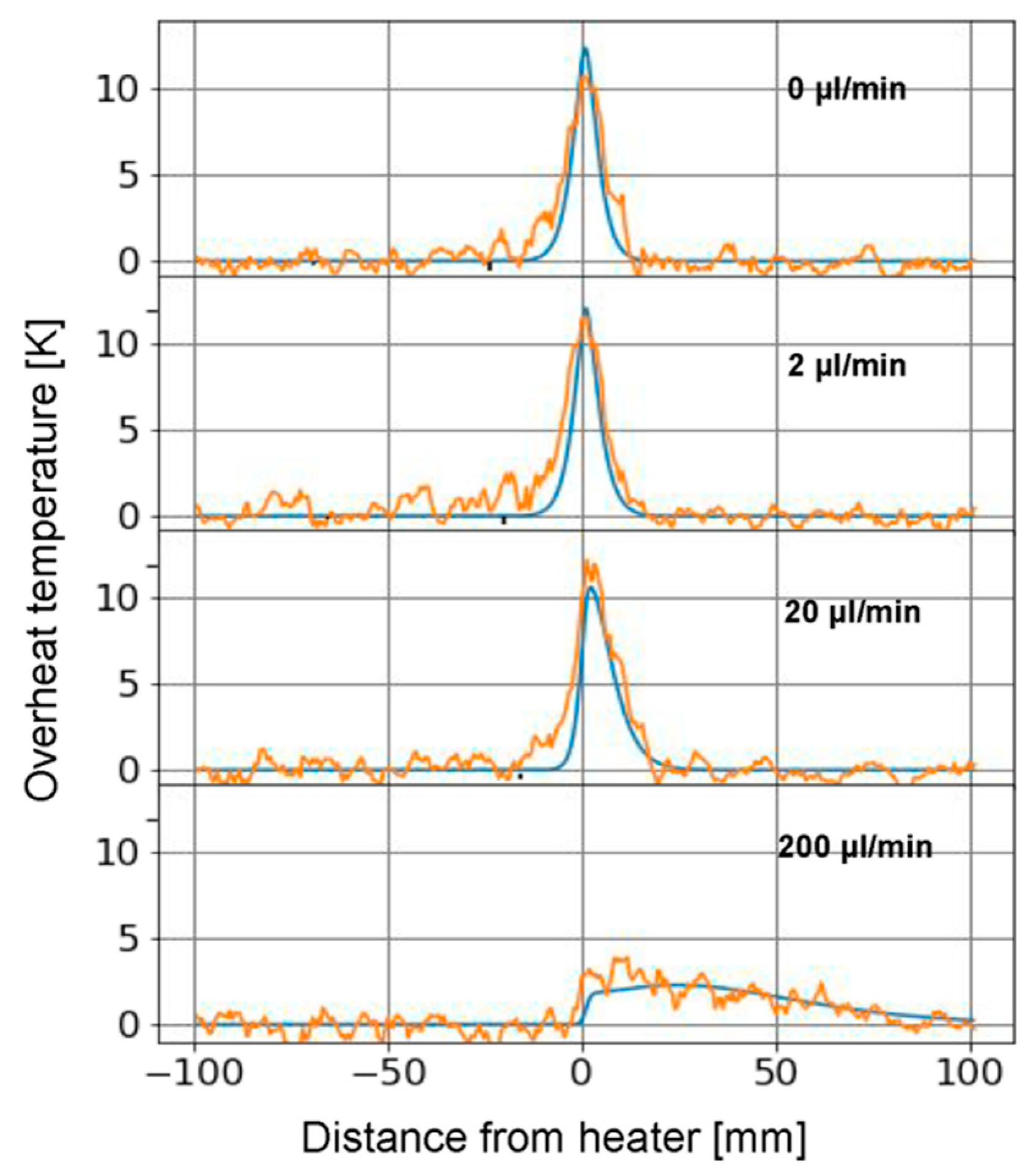
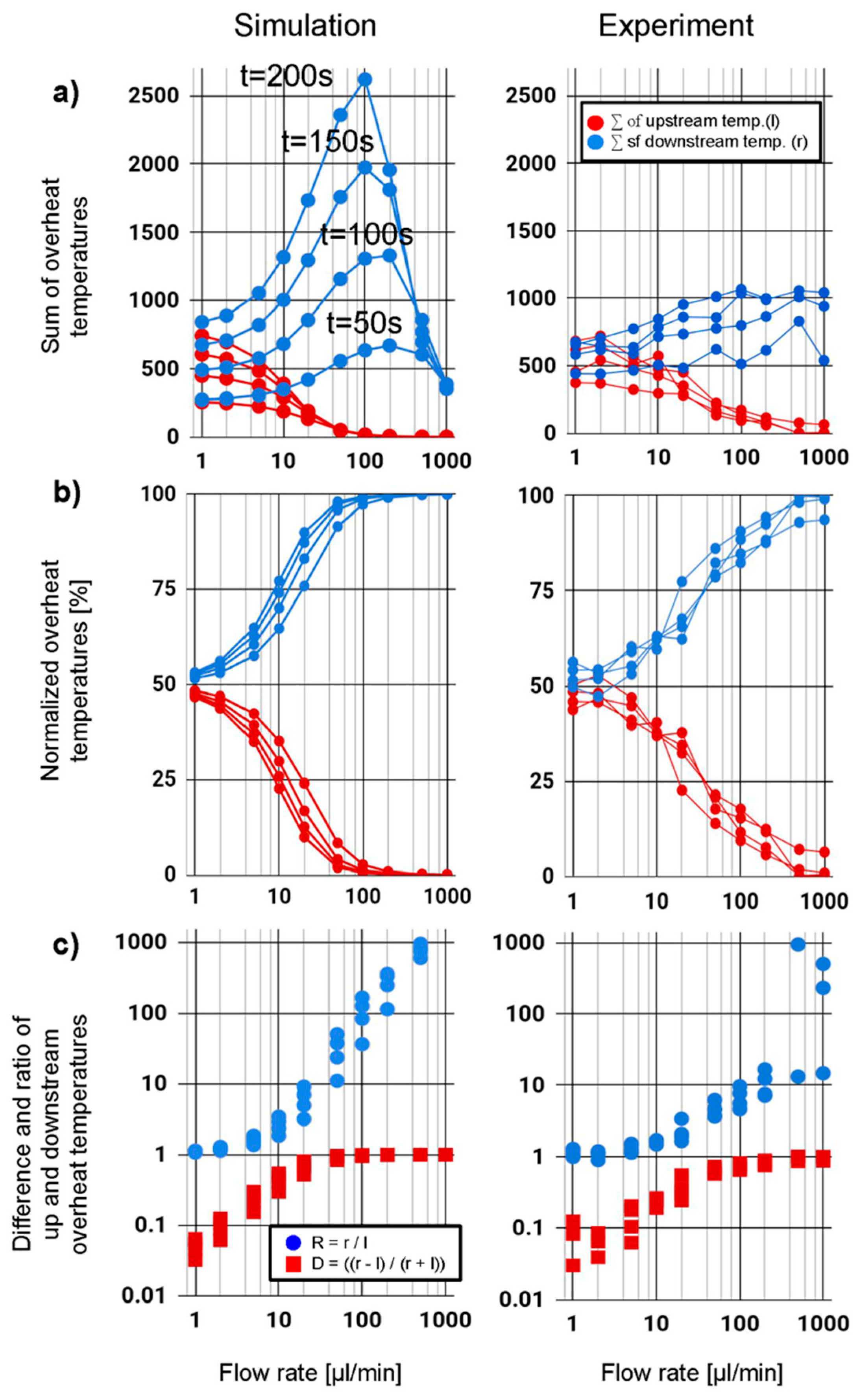
© 2019 by the authors. Licensee MDPI, Basel, Switzerland. This article is an open access article distributed under the terms and conditions of the Creative Commons Attribution (CC BY) license (http://creativecommons.org/licenses/by/4.0/).
Share and Cite
Jderu, A.; Enachescu, M.; Ziegler, D. Mass Flow Monitoring by Distributed Fiber Optical Temperature Sensing. Sensors 2019, 19, 4151. https://doi.org/10.3390/s19194151
Jderu A, Enachescu M, Ziegler D. Mass Flow Monitoring by Distributed Fiber Optical Temperature Sensing. Sensors. 2019; 19(19):4151. https://doi.org/10.3390/s19194151
Chicago/Turabian StyleJderu, Alin, Marius Enachescu, and Dominik Ziegler. 2019. "Mass Flow Monitoring by Distributed Fiber Optical Temperature Sensing" Sensors 19, no. 19: 4151. https://doi.org/10.3390/s19194151




